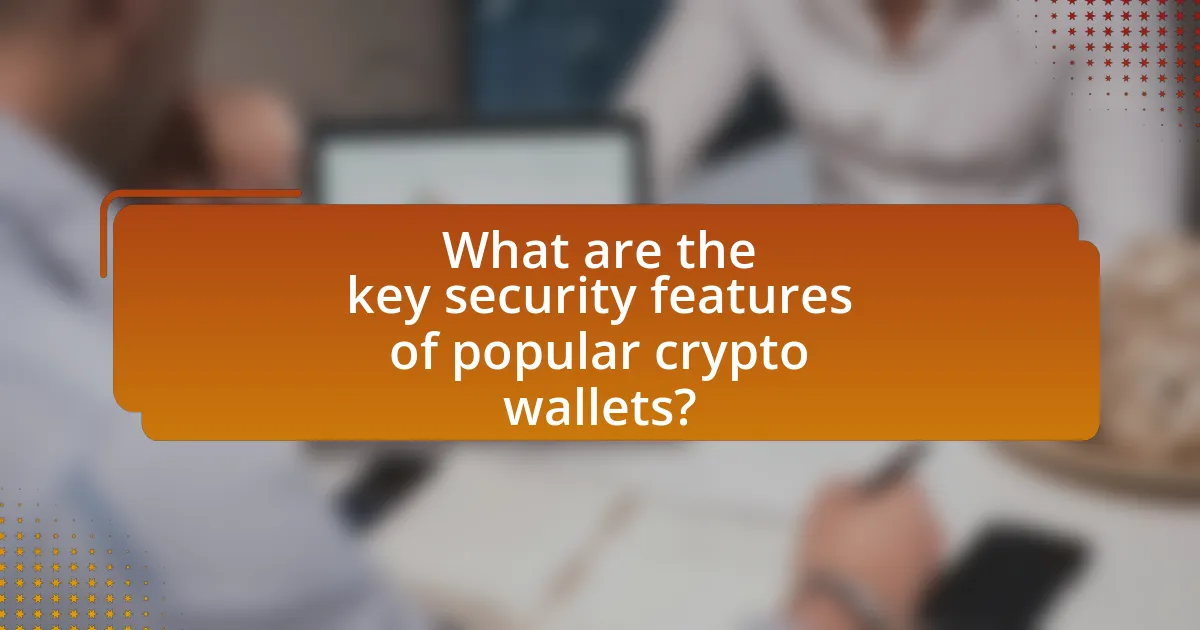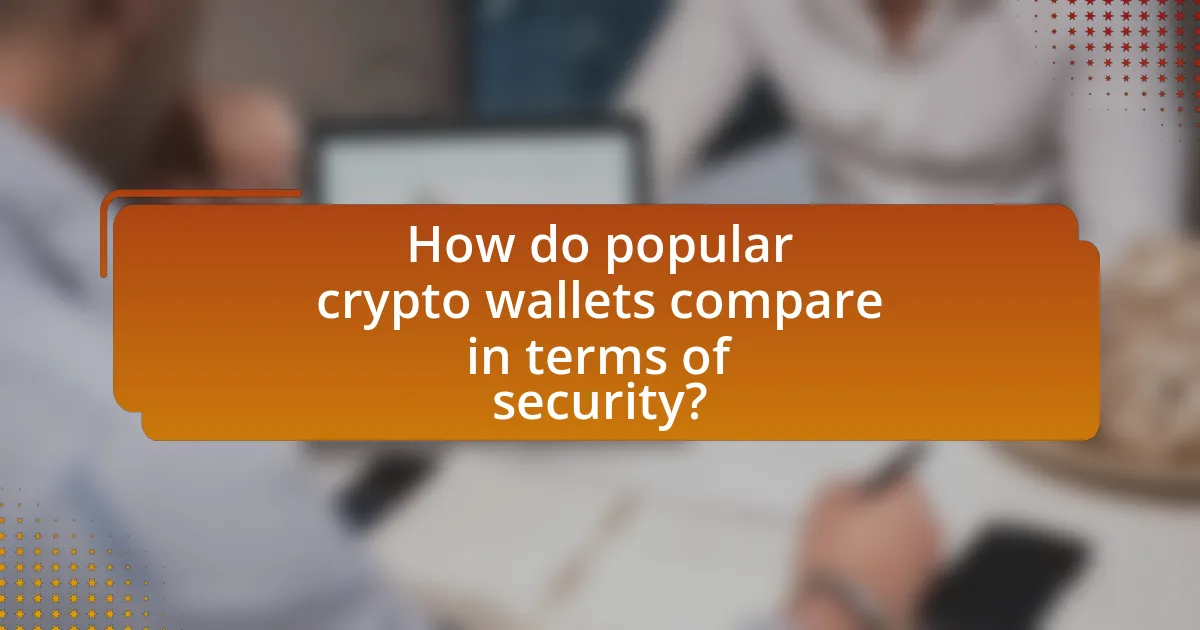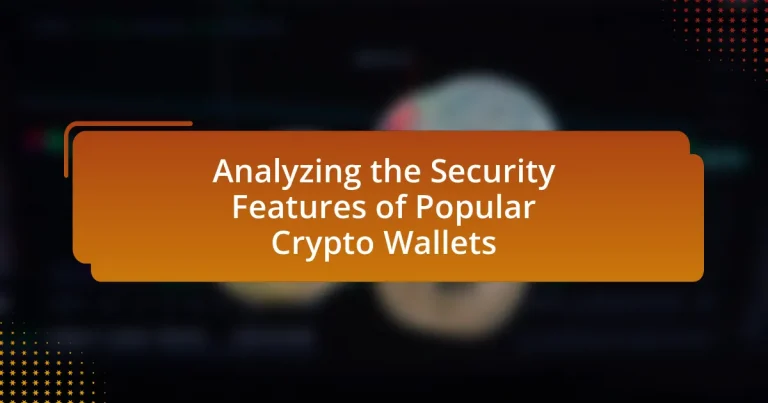The article focuses on the security features of popular crypto wallets, highlighting essential aspects such as private key management, two-factor authentication (2FA), encryption, and backup options. It examines how different wallet types—hardware, software, and paper wallets—enhance security through various mechanisms. The discussion includes common security measures in hardware wallets, the role of encryption in protecting user data, and the importance of private key management. Additionally, the article compares the security ratings of leading wallets, identifies vulnerabilities, and outlines best practices users can follow to enhance wallet security and recover funds after a compromise.

What are the key security features of popular crypto wallets?
The key security features of popular crypto wallets include private key management, two-factor authentication (2FA), encryption, and backup and recovery options. Private key management ensures that users have sole control over their keys, which are essential for accessing their funds. Two-factor authentication adds an extra layer of security by requiring a second form of verification, such as a code sent to a mobile device. Encryption protects sensitive data within the wallet, making it difficult for unauthorized users to access it. Backup and recovery options allow users to restore their wallets in case of loss or theft, ensuring that they do not lose access to their assets. These features are critical in safeguarding digital currencies against theft and unauthorized access.
How do different types of crypto wallets enhance security?
Different types of crypto wallets enhance security through varying mechanisms tailored to protect digital assets. Hardware wallets, for instance, store private keys offline, significantly reducing the risk of online hacks, as they are not connected to the internet. Software wallets, including mobile and desktop versions, often incorporate encryption and two-factor authentication, adding layers of security against unauthorized access. Paper wallets, which involve printing private keys on paper, eliminate digital vulnerabilities entirely, though they require careful physical storage to prevent loss or damage. Each wallet type addresses specific security concerns, making them suitable for different user needs and risk tolerances.
What security measures are common in hardware wallets?
Common security measures in hardware wallets include secure element chips, PIN protection, and recovery seed phrases. Secure element chips provide a tamper-resistant environment for storing private keys, ensuring that sensitive information is protected from unauthorized access. PIN protection requires users to enter a unique code to access the wallet, adding an additional layer of security against theft. Recovery seed phrases, typically consisting of 12 to 24 words, allow users to restore their wallets in case of loss or damage, ensuring that access to funds is maintained even if the device is compromised. These measures collectively enhance the overall security of hardware wallets, making them a preferred choice for storing cryptocurrencies.
How do software wallets protect user data?
Software wallets protect user data through encryption, secure key management, and multi-factor authentication. Encryption ensures that sensitive information, such as private keys and transaction data, is stored in a format that is unreadable without the correct decryption key. Secure key management involves generating and storing private keys locally on the user’s device rather than on centralized servers, reducing the risk of unauthorized access. Multi-factor authentication adds an additional layer of security by requiring users to verify their identity through multiple methods, such as a password and a biometric scan. These combined measures significantly enhance the security of user data in software wallets.
Why is encryption important in crypto wallets?
Encryption is crucial in crypto wallets because it protects sensitive information, such as private keys and transaction data, from unauthorized access. By employing strong encryption algorithms, crypto wallets ensure that even if a hacker gains access to the wallet’s data, they cannot decipher the information without the correct decryption key. For instance, wallets that utilize AES (Advanced Encryption Standard) provide a high level of security, making it significantly more difficult for attackers to compromise user assets. This encryption not only safeguards individual users but also maintains the overall integrity of the cryptocurrency ecosystem by preventing fraud and theft.
What types of encryption are used in crypto wallets?
Crypto wallets utilize several types of encryption to secure user data and assets, primarily symmetric encryption, asymmetric encryption, and hashing. Symmetric encryption, such as AES (Advanced Encryption Standard), is commonly used to encrypt private keys, ensuring that only authorized users can access their funds. Asymmetric encryption, which involves a public and private key pair, allows users to securely send and receive cryptocurrencies without exposing their private keys. Hashing algorithms, like SHA-256, are employed to create unique digital signatures for transactions, ensuring data integrity and authenticity. These encryption methods collectively enhance the security of crypto wallets, protecting against unauthorized access and fraud.
How does encryption impact wallet security?
Encryption significantly enhances wallet security by protecting sensitive information, such as private keys and transaction data, from unauthorized access. When a wallet employs strong encryption algorithms, it ensures that even if the data is intercepted or accessed by malicious actors, it remains unreadable without the correct decryption key. For instance, wallets that use AES (Advanced Encryption Standard) encryption provide a robust layer of security, making it exceedingly difficult for attackers to compromise the wallet’s contents. This is evidenced by the fact that encrypted wallets are less susceptible to hacking incidents, as demonstrated by a study from the University of Cambridge, which found that encrypted wallets had a significantly lower rate of successful breaches compared to non-encrypted alternatives.
What role do private keys play in wallet security?
Private keys are essential for wallet security as they provide the sole means of accessing and managing cryptocurrency assets. Each wallet is associated with a unique private key that must be kept confidential; if someone gains access to this key, they can control the funds within the wallet. The security of cryptocurrencies relies on cryptographic principles, where the private key is used to sign transactions, proving ownership and authorizing transfers. According to the Bitcoin whitepaper by Satoshi Nakamoto, the integrity of the system hinges on the secrecy of private keys, as losing or exposing them can lead to irreversible loss of assets.
How are private keys generated and stored securely?
Private keys are generated using cryptographic algorithms, such as the Elliptic Curve Digital Signature Algorithm (ECDSA), which ensures that the keys are unique and secure. These keys are typically stored securely in hardware wallets, which isolate them from internet access, or in software wallets that employ strong encryption methods to protect the keys. For instance, hardware wallets like Ledger and Trezor generate private keys offline, minimizing exposure to potential online threats. Additionally, secure storage practices include using seed phrases for recovery, which are also kept offline and encrypted, further enhancing security against unauthorized access.
What are the risks associated with private key management?
The risks associated with private key management include loss, theft, and unauthorized access. Loss of private keys can result in permanent loss of access to cryptocurrency assets, as there is no recovery mechanism. Theft can occur through phishing attacks, malware, or physical theft, leading to unauthorized transactions. Unauthorized access can happen if private keys are stored insecurely, such as on cloud services without encryption, making them vulnerable to hacking. According to a report by Chainalysis, over $3.2 billion in cryptocurrency was stolen in 2020 alone, highlighting the critical importance of secure private key management practices.

How do popular crypto wallets compare in terms of security?
Popular crypto wallets vary significantly in terms of security features. Hardware wallets, such as Ledger and Trezor, provide superior security by storing private keys offline, making them less vulnerable to hacking. In contrast, software wallets like Exodus and Trust Wallet, while user-friendly, are more susceptible to malware and phishing attacks due to their online nature.
For instance, Ledger has implemented a secure element chip that protects against physical tampering, while Trezor offers a recovery seed feature that allows users to restore their wallets if lost. On the other hand, software wallets often rely on encryption and two-factor authentication, which, although effective, do not match the robustness of hardware solutions.
According to a report by the Blockchain Security Alliance, hardware wallets are considered the safest option for long-term storage of cryptocurrencies, with a significantly lower incidence of theft compared to software wallets. This comparison highlights the critical differences in security measures across popular crypto wallets.
What are the security ratings of leading crypto wallets?
Leading crypto wallets have varying security ratings based on factors such as encryption, two-factor authentication, and user control over private keys. For instance, hardware wallets like Ledger and Trezor typically receive high security ratings due to their offline storage capabilities and robust encryption methods. In contrast, software wallets like Exodus and Trust Wallet may have lower ratings because they are more susceptible to online threats, despite offering features like backup recovery phrases and biometric security. According to a report by the Blockchain Security Alliance, hardware wallets are considered the most secure option, with a rating of 9/10, while software wallets generally range from 6/10 to 8/10 depending on their specific security features.
Which wallets are considered the most secure and why?
Hardware wallets, such as Ledger Nano X and Trezor Model T, are considered the most secure due to their offline storage of private keys, which protects them from online hacking attempts. These wallets utilize secure elements and encryption to safeguard sensitive information, making them less vulnerable to malware and phishing attacks. For instance, Ledger’s hardware wallets have undergone extensive security audits and have a proven track record of protecting users’ assets, with over 3 million devices sold globally. Additionally, Trezor’s open-source software allows for community scrutiny, enhancing trust in its security measures.
How do user reviews reflect wallet security performance?
User reviews reflect wallet security performance by providing firsthand accounts of user experiences with security features and incidents. These reviews often highlight specific vulnerabilities, such as susceptibility to hacks or phishing attacks, and can indicate the effectiveness of security measures like two-factor authentication and encryption. For instance, a study by the University of Cambridge found that user feedback on wallet security often correlates with reported security breaches, demonstrating that negative reviews frequently arise after incidents of compromised wallets. This direct feedback serves as a valuable resource for potential users to assess the reliability and security of different wallets based on real-world experiences.
What vulnerabilities have been identified in popular wallets?
Vulnerabilities identified in popular wallets include private key exposure, phishing attacks, and software bugs. Private key exposure occurs when users fail to securely store their keys, leading to unauthorized access to funds. Phishing attacks target users through deceptive emails or websites, tricking them into revealing sensitive information. Software bugs have been documented in various wallet applications, which can lead to unexpected behavior or security flaws, as seen in incidents reported by cybersecurity firms. For example, a 2021 report by CipherTrace highlighted vulnerabilities in several wallet applications that could be exploited by attackers, emphasizing the need for robust security measures.
What incidents have highlighted security flaws in crypto wallets?
Several incidents have highlighted security flaws in crypto wallets, notably the 2014 Mt. Gox hack, where approximately 850,000 Bitcoins were stolen due to inadequate security measures. This incident exposed vulnerabilities in wallet security protocols and led to significant regulatory scrutiny. Another example is the 2020 hack of the Twitter accounts of high-profile individuals, which involved a phishing attack targeting crypto wallet users, resulting in over $100,000 in Bitcoin being stolen. Additionally, the 2021 Poly Network hack, where over $600 million was exploited due to a flaw in the wallet’s smart contract, further underscored the risks associated with crypto wallets. These incidents collectively demonstrate the critical need for enhanced security features in crypto wallet technology.
How have wallet providers responded to security breaches?
Wallet providers have responded to security breaches by enhancing their security protocols and implementing more robust measures. For instance, many wallet providers have adopted multi-signature technology, which requires multiple approvals for transactions, thereby reducing the risk of unauthorized access. Additionally, they have increased their focus on user education regarding security best practices, such as enabling two-factor authentication and using hardware wallets for storing private keys. According to a report by CipherTrace, following significant breaches, wallet providers have also invested in advanced threat detection systems and regular security audits to identify vulnerabilities proactively. These actions demonstrate a commitment to improving security and protecting user assets in the wake of breaches.

What best practices can users follow to enhance wallet security?
To enhance wallet security, users should implement multi-factor authentication (MFA) as a primary measure. MFA significantly reduces the risk of unauthorized access by requiring multiple forms of verification, such as a password and a one-time code sent to a mobile device. According to a study by Microsoft, enabling MFA can block over 99.9% of account compromise attacks. Additionally, users should regularly update their wallet software to protect against vulnerabilities, as outdated software can be exploited by attackers. Using strong, unique passwords for wallet accounts further strengthens security, as weak passwords are easily guessed or cracked. Lastly, users should store their private keys offline in a secure location, minimizing exposure to online threats.
How can users protect their wallets from unauthorized access?
Users can protect their wallets from unauthorized access by implementing strong security measures such as using two-factor authentication (2FA), employing hardware wallets, and regularly updating software. Two-factor authentication adds an extra layer of security by requiring a second form of verification, making it significantly harder for unauthorized users to gain access. Hardware wallets, which store private keys offline, provide a secure environment that is less susceptible to hacking compared to online wallets. Regularly updating wallet software ensures that users benefit from the latest security patches and features, reducing vulnerabilities. These practices are supported by cybersecurity studies indicating that multi-layered security approaches significantly decrease the likelihood of unauthorized access.
What role does two-factor authentication play in wallet security?
Two-factor authentication (2FA) significantly enhances wallet security by requiring users to provide two forms of verification before accessing their accounts. This additional layer of security mitigates the risk of unauthorized access, as even if a password is compromised, the attacker would still need the second factor, typically a code sent to a mobile device or generated by an authentication app. According to a study by Google, implementing 2FA can block 99.9% of automated attacks, demonstrating its effectiveness in protecting sensitive information and assets stored in crypto wallets.
How can users create strong passwords for their wallets?
Users can create strong passwords for their wallets by combining a mix of uppercase and lowercase letters, numbers, and special characters, while ensuring the password is at least 12 characters long. This complexity makes it significantly harder for attackers to guess or crack the password. Research indicates that passwords meeting these criteria can reduce the risk of unauthorized access by up to 80%, as they are less susceptible to brute-force attacks. Additionally, users should avoid using easily guessable information, such as birthdays or common words, to further enhance security.
What steps should users take if they suspect a security breach?
If users suspect a security breach, they should immediately change their passwords for all accounts associated with the affected service. This action helps prevent unauthorized access. Following the password change, users should enable two-factor authentication (2FA) to add an extra layer of security. Users must also review account activity for any unauthorized transactions or changes, and report suspicious activity to the service provider. Additionally, users should run antivirus and anti-malware scans on their devices to detect any malicious software that may have contributed to the breach. Finally, users should consider monitoring their financial accounts and credit reports for any signs of identity theft.
How can users recover their funds after a wallet compromise?
Users can recover their funds after a wallet compromise by following a series of steps that include securing their recovery phrase, contacting wallet support, and monitoring their accounts. First, users should immediately secure their recovery phrase or private keys to prevent further unauthorized access. Next, they should reach out to the wallet provider’s support team, as some wallets may have recovery options or procedures in place for compromised accounts. Additionally, users should monitor their accounts for any unauthorized transactions and consider transferring remaining funds to a new, secure wallet. These actions are critical because timely intervention can help mitigate losses and restore access to funds.
What preventive measures can users implement to avoid future breaches?
Users can implement several preventive measures to avoid future breaches, including enabling two-factor authentication (2FA), using strong and unique passwords, and regularly updating wallet software. Two-factor authentication adds an extra layer of security by requiring a second form of verification, significantly reducing the risk of unauthorized access. Strong passwords, ideally a mix of letters, numbers, and symbols, help protect against brute-force attacks. Regular software updates ensure that users benefit from the latest security patches, addressing vulnerabilities that could be exploited by attackers. According to a report by the Cybersecurity & Infrastructure Security Agency, implementing these measures can reduce the likelihood of breaches by up to 80%.


